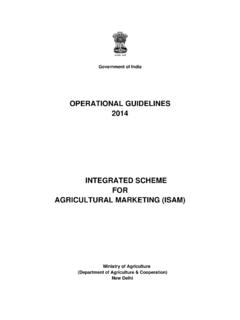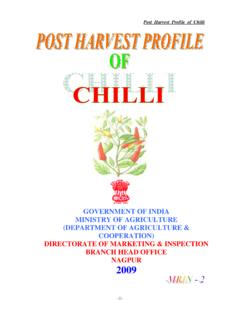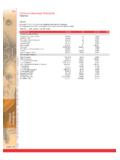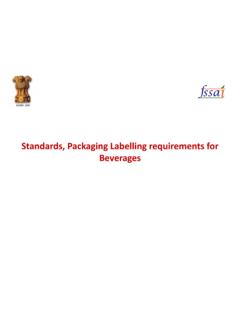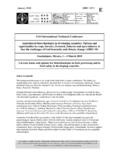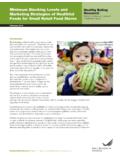Transcription of POST HARVEST PROFILE OF BANANA: 2015 - …
1 GOVERNMENT OF INDIA MINISTRY OF AGRICULTURE (DEPARTMENT OF AGRICULTURE & COOPERATION) DIRECTORATE OF MARKETING & INSPECTION BRANCH HEAD OFFICE NAGPUR MRIN post HARVEST PROFILE OF banana : 2015 P R E F A C E banana (Musa sapientum) is an important fruit crop in India. Bananas are grown in more than 150 countries, producing 105 million tonnes of fruit per year. The global production of banana is around thousand tons of which India contributes Main banana growing states are Tamil Nadu, Maharashtra, Gujarat, Andhra Pradesh and Karnataka. The Inter-Ministerial Task Force on Agricultural Marketing Reforms (May, 2002), suggested several measures for strengthening agricultural marketing system in the country for benefiting the farming community to enhance the share of farmers in the ultimate price of their produce as well as for various market functionaries in the new liberalized global market opportunities and to foster true competition among the market players.
2 This PROFILE has been prepared on the recommendation of the Inter-Ministerial Task Force with a view to enable the farming community to scientifically manage the post - HARVEST operations and to widening awareness for better marketing of the bananas. The PROFILE covers almost all aspects of the marketing, such as post - HARVEST management, marketing practices, quality standards, grading, packaging, transportation, storage, SPS requirements, marketing problems, marketing information, etc. This post - HARVEST PROFILE of banana has been prepared by Shri Akshay Yakub, Senior Marketing Officer under the supervision of Shri C R Jena, Deputy Agricultural Marketing Adviser and assisted by Ms. Aparajita Ghosh, Junior Statistical Officer, Directorate of Marketing and Inspection, Branch Head Office, Nagpur.
3 The Directorate of Marketing and Inspection gratefully acknowledges the assistance and co-operation extended by various Government/ Semi Government/ Private organizations in supplying the relevant data/information required for compilation of the PROFILE . The Government of India should not be regarded as assuming responsibility for any of the statements contained in this PROFILE . Faridabad Dated: Agricultural Marketing Adviser to the Govt. of India (i) TABLE OF CONTENTS _____ (ii) PREFACE ( i ) CHAPTER I INTRODUCTION 1 - 3 CHAPTER II AREA AND PRODUCTION 4 - 14 CHAPTER III post HARVEST MANAGEMENT 15 37 CHAPTER IV post HARVEST DISEASES & DISORDERS 38 41 CHAPTER V MARKETING 42 47 CHAPTER VI MARKETING COST & MARGINS 48 54 CHAPTER VII PROCESSING & USES 55 - 63 CHAPTER VIII MARKETING INFORMATION & EXTENSION 64 - 68 CHAPTER IX ALTERNATIVE SYSTEMS OF MARKETING 69 - 87 CHAPTER I: INTRODUCTION banana is the most popular fresh fruit all over the world and its name comes from the Arabic word 'banan', which means finger.
4 The scientific name of banana is Musa acuminata and Musa balbisiana. But the old scientific names of banana are Musa sapientum and Musa paradisiacal. Bananas are rich source carbohydrates and potassium. These are the first choice of athletes owing to its high energy potential. banana is a large perennial herb with leaf sheaths that form the trunk like pseudostem. banana was first domesticated in the tropical regions of South East Asia. banana is a nutritious gold mine. Its high Vitamin B6 content helps fight infection and is essential for the synthesis of heme , the iron containing pigment of hemoglobin. The fruit is also rich in potassium and a great source of fibre too. In recent years, considering the adverse impact of indiscriminate use of chemicals, new trend of organic banana production has been adopted worldwide.
5 A novel name, "Green Foods" for this has been texts of 600 BC for the first time in history mentioned banana as a highly nutritive food. Their chronicles describe a beverage made from banana which the monks were allowed to drink. Travelogues of 327 BC mention that Alexander the Great discovered the taste of banana in the valleys of India. In the year 200 AD, China had an organized banana plantation. Islamic conquerors brought banana to Palestine in 650 AD. The Arab merchants succeeded in spreading banana cultivation all over Africa. In 1502 AD, colonists started the first banana plantation in the Caribbean and in Central America. Thus banana consumption had been in vogue for thousands of years.
6 Also, it is interwoven with national heritage and culture. It is one of the oldest fruits known to mankind. banana is one of the world s most important food crops. In India, banana crop accounts for per cent of agricultural GDP. It is an important crop for subsistence farmers, and ensures year-round security for food or income. Bananas were redistributed and rediscovered for a second time around the Indian Ocean by the wave of Islam. Referenced in Islamic literature in the 11th century BCE, Muslim merchants traded banana along trade routes to and from various places in South Asia and the Middle East. By the 1200s, banana reached North Africa and Moorish-controlled Spain. It is also likely that Islamists carried banana from eastern to western Africa.
7 A third wave of banana diffusion occurred in both Asia and in Europe. By the 1200s, 1 Japanese cultivators harvested specific banana varieties for their fibers, to forge into textiles for clothes and other fabrics. In Europe, the Moorish invasions had likely brought the banana for the first time into the continent. By the 15th and 16th century, Portuguese sailors were establishing the crop throughout Brazil, where it likely spread to the sugar plantation economies of the New World and the Caribbean. Table : Chemical Composition Ingredient Percent Ingredient Percent Ingredient Percent Moisture contents 75 Histidine 11 Isoleucine 3 Sugar 12 Leucine 7 Proline 3 Glucose 48 Lysine 5 Tryptophane 1 Fructose 40 Phynalylaline 4 Custine 1 Maltose Less than 1 Arginine 4 Tyrosine 1 Starch 5 Valine 4 Methionine 1 Fibre E 460 3 Alanine 4 Fatty Acid 1 Amino Acid 3 Sarine 4 Ash 6 Glutamic Acid 19 Glycine 3 Aspartic Acid 16 Threonine 3 Source: International Journal of Tropical Medicine and Public Health ECONOMICAL IMPORTANCE: banana is a very popular fruit due to its low price and high nutritive value.
8 It is consumed both in fresh and cooked form both as ripe and raw fruit. banana is a rich source of carbohydrate and is rich in vitamins particularly vitamin B. It is also a good source of potassium, phosphorus, calcium and magnesium. The fruit is easy to digest, free from fat and cholesterol. banana powder is used as the first baby food. It helps in reducing the risk of heart diseases when used regularly and is recommended for patients suffering from high blood pressure, arthritis, ulcer, gastroenteritis and kidney disorders. Processed products, such as chips, banana puree, jam, jelly, juice, wine and halwa can be made from the fruit. The tender stem, which bears the inflorescence is extracted by removing the leaf sheaths of the harvested pseudostem and used as vegetable.
9 Plantains or cooking bananas are rich in starch and have a chemical composition similar to that of potato. banana fibre is used to make items like bags, pots and wall hangers. Rope and good quality paper can be prepared from banana waste. banana leaves are used as healthy and hygienic eating plates 2 PLANT DESCRIPTION: banana plant can be found very easily in one's yard or gardens as they are very easy to cultivate and it is the largest herbaceous flowering plant. It can grow up to 6 to meters (20 to ft) tall and its leaves can grow up to meters ( ft) long and 60 cm ( ft) wide. The banana plant is a large perennial herb with leaf sheaths that form trunk-like pseudostems.
10 The plant has 8 - 12 leaves that are up to 9 ft long and 2 ft wide. Root development may be extensive in loose soil in some cases up to 30 ft laterally. Other plant descriptions vary, it depends on the variety. Flower development gets initiated from the true stem underground (corm) 9 - 12 months after planting. The inflorescence (flower stalk) grows through the center of the pseudostem. Flowers develop in clusters and spiral around the main axis. In most cultivars, the female flowers are followed by a few "hands" of neuter flowers that have aborted ovaries and stamens. The neuter flowers are followed at the terminal ends by male flowers enclosed in bracts. The male flowers have functional stamens but aborted ovaries.
